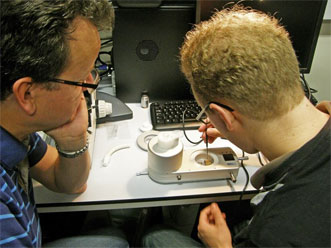Temperature-controlled stages have been used to fend off heat damage to cells caused by illumination in correlative light and electron microscopy (CLEM) experiments.
A research group at the University of Bristol used stages from Linkam Scientific Instruments Ltd. of Tadworth to study a process of the endocytic system, which transports molecular cargo inside cells. Specifically they were interested in how recycling cargo is segregated from degradative cargo.
"In order to study these processes, we use a lot of live light microscopy to follow these dynamic events," said Paul Verkade, a reader in cell imaging in the School of Biochemistry at the University of Bristol and head of the electron microscopy unit of the Wolfson Bioimaging Facility. "However, the resolution of the light microscope is too low to visualize certain aspects (e.g., recycling membrane tubules are about 50 nm in diameter). Thus we want to capture specific stages of the live imaging and analyze those in more detail in the electron microscope in experiments."

Researchers at Wolfson Bioimaging Facility load a Linkam stage. Courtesy of Linkam Scientific Instruments.
Verkade and his team used two different Linkam stages for workflows within the experiment.
In order to preserve cell ultrastructures in their native condition, samples were frozen very rapidly. The researchers used the Linkam CMS196 correlative microscopy stage to check the state and fluorescence of the frozen samples. If the sample was determined to be suitable, it was further processed using either cryogenic transmission electron microscopy or by performing freeze substitution and resin embedding.
The second Linkam stage used was a cooling stage for a photoconversion microscope. In this workflow, a fluorescent sample was illuminated very heavily to create oxygen radicals that could be turned into an electron-dense precipitate. However, shining so much light on the sample heats it; without efficient cooling of the sample — in this case, using the water-cooled stage — the sample would burn, leading to melting or explosion.
Linkam develops and manufactures temperature-controlled stages from high to cryogenic temperatures for OEMs and end users. The stages are used in conjunction with light microscopes and a range of analytical techniques including Raman, Fourier transform IR spectroscopy and x-ray techniques to visualize and characterize the properties of materials.